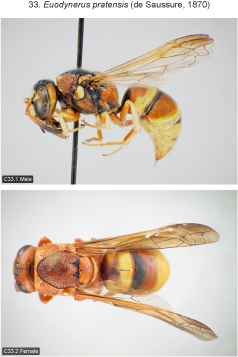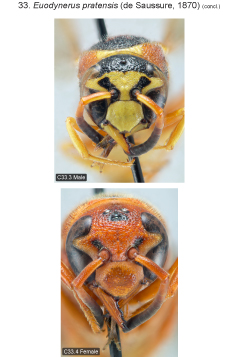
| Home | Table of contents | Keys | Species list | Glossary | Image data | PDF | Cite this article | Feedback | Updates |
Identification Atlas of the Vespidae (Hymenoptera, Aculeata) of the northeastern Nearctic region
CJAI 05, February 19, 2008
doi: 10.3752/cjai.2008.05
Matthias Buck, Stephen A. Marshall, and David K.B. Cheung
Department of Environmental Biology, University of Guelph, Guelph, Ontario, Canada N1G 2W1
Next species | Previous species | Key
33. Euodynerus pratensis (de Saussure, 1870)
Figs B5.56; C33.1–4.

|

|
Species recognition. Euodynerus pratensis stands out among all Nearctic Euodynerus because of its largely impunctate tergum 2 (excluding the coarsely punctate apical fascia). Further diagnostic characters include: scutellum and apical portions of terga 2–6(7) with long, erect hairs (hair length distinctly greater than one mid ocellar diameter; long hairs also present in E. boscii but covering terga completely including tergum 1); submarginal carina of propodeum angularly produced (character shared with E. boscii and E. annulatus); male fore femur with a weak, inconspicuous swelling ventrally in basal half (similar but better developed in E. boscii); male flagellomere XI relatively small and slender, neither flattened nor apically expanded (larger and slightly flattened in E. boscii; distinctly larger, apically expanded and conspicuously flattened in E. annulatus).
Variation. Fore wing length 8.5–11.5 mm (♂♂), 10.5–12 mm (♀♀) (Bequaert 1936, and own observation). Specimens from the northwestern part of the range (WA and ID south to northeastern CA, NV) are mainly black and yellow with very limited amounts of ferruginous. Elsewhere the species is mostly ferruginous and yellow with very restricted black markings. The latter form is the one that has been recorded from Ontario.
Distribution. Canada: recorded from ON by Bohart (1951). Western U.S.: WA and ID to CA, east to KS, TX (Krombein 1979). Mexico: Tamaulipas, Nuevo León, Baja California (Rodríguez-Palafox 1996). The ssp. brumalis (Bequaert, 1936) ranges from ID and WA to CA and NV. Bohart (1951) published neither a specimen depository nor further locality data for his record from Ontario. During this study no eastern Nearctic material of E. pratensis was found. The occurrence of this western species in Ontario appears highly unlikely. It seems possible that Bohart’s record is based on misinterpreted or wrong label data.
Biology. Nests in borings in wood and Sambucus stems. Cell partitions and closing plugs are made out of mud. Caterpillars serve as prey (Krombein 1967, 1979).
Next species | Previous species | Key
| Home | Table of contents | Keys | Species list | Glossary | Image data | PDF | Cite this article | Feedback | Updates |
